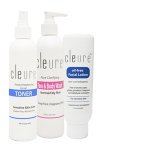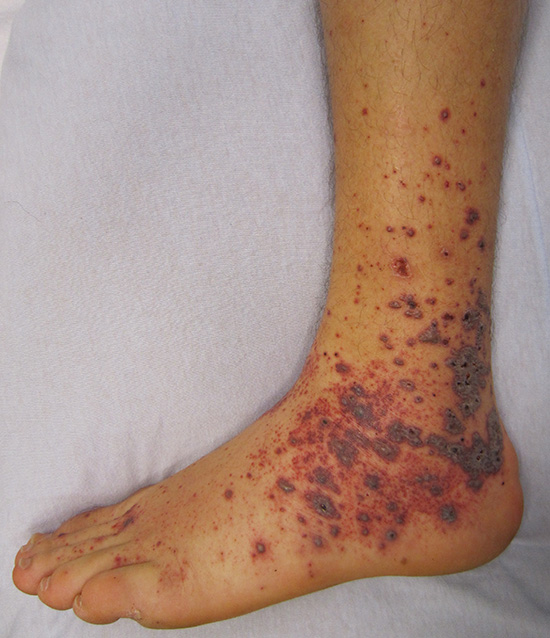Perioral Dermatitis
There is Hope!
Perioral dermatitis is a common skin condition characterized by a rash around the mouth. The rash may spread to the nose, around the eyes, or to the forehead.
If the rash spreads to the eyes it is called periorbital dermatitis, and the two conditions together are known as periorificial dermatitis.
Usually, the rash consists of red bumps similar to acne or skin that appears dry and flaky, accompanied by itchiness or a burning sensation.
The condition is most often chronic, so someone who has it once will likely be affected by it again.
It is substantially more common for women to have perioral dermatitis than men, but some men do have it as well. It's not something that can be spread from one person to another.
When you first notice a rash around your mouth, you might reach for some kind of lotion or cream in an attempt to ease the burning or itchy feeling. Women may also be inclined to try covering up the affected skin with cosmetics.
These things will usually make the situation worse.
Triggers and Contributors
In many cases, perioral dermatitis becomes apparent after applying topical steroids to the face to treat another skin problem. A nasal spray containing steroids could also cause or trigger the condition.
The rash is usually a result of persistent or prolonged irritation of the skin, which can be caused by a variety of different chemicals or a combination of different products.
Anything you use on your face or hands can contribute to irritation of the parts of your face where the skin is most sensitive, around your mouth, nose and eyes. Some of the usual suspects include:
- Mineral oil – used as a moisturizer in cosmetics, cleansers, lotions
- Parabens – chemicals used as preservatives in shampoos, cosmetics, toothpaste, shaving gel, moisturizers, spray tan, also food
- Sodium lauryl sulfate – used in shampoos, detergents, shaving foam, toothpaste, to create lather
- Petroleum jelly – used as a lubricant in cosmetics, lotions, lip moisturizers
- Isopropyl myristate – added to cosmetics and topical medications to increase absorption by the skin
- Fluoride – used in most toothpastes
Each person's skin reacts differently to various products. Ultimately, it depends on your own chemical composition, your biological balance.
Someone who believes their skin is not sensitive at all may begin to overuse skin care products, eventually triggering a negative reaction in the skin, like perioral dermatitis.
You can actually develop an allergy to something you've used regularly, without incident, for a long period of time. They're much harder to reverse once you've developed an allergy, so you can usually expect the same allergic reaction when you use the offending product in the future.
There is always a nutritional element to skin care. A deficiency or excess of one component or another can contribute to flare-ups of dermatitis.
Treatment Options
Doctors who are not dermatologists will often prescribe a very strong steroid cream. It can either temporarily improve your symptoms or it can make them worse.
The long-term use of topical steroids is known to cause thinning of the skin. Improvements quickly reverse when you stop using them, with symptoms returning more severe.
Dermatologists tend to advise perioral dermatitis patients not to continue using any corticosteroids, including over-the-counter hydrocortisone. Instead, they often suggest taking an antibiotic, either orally or applied to the skin.
Women with concerns about the overuse of antibiotics have come up with an interesting and tasty home remedy that works splendidly for some cases. You can cover your face, or just the affected areas, with yogurt and leave it on for 10 or 15 minutes.
The acidophillus in yogurt helps boost healthy bacteria in your body to fight harmful bacteria. As an alternative you can take a probiotic supplement, this is also a good idea anytime you take antibiotics.
Some dermatologists may suggest using a facial cleanser that contains pyrithione zinc or ketoconazole. They can help rid your skin of candida yeast, but it can be risky for some people to use them.
An alternative, which has reportedly aided in resolving the yeast issue in many cases, is apple cider vinegar. You can find many recipes for facial scrubs and masks that use apple cider vinegar, or you can apply it directly to your face diluted with a little water, with a cottonball or washcloth.
The most common recommendation for treating perioral dermatitis is to stop using all of your usual skin care products and cosmetics.
Avoid using any new ones until your skin is back to normal. When you want to start using products again, be very selective in choosing which ones you use.
I've done a great deal of research about this myself because of my own sensitive skin problems, and it is not as easy as it seems to find safe, non-toxic products for your skin. Please visit our hypoallergenic products page to learn why most popular sensitive skin care products contain ingredients that can cause skin rashes!
Prevention Methods
In order to prevent future flare-ups when you've got your symptoms under control, you'll have to find a way of addressing the factors which trigger a reaction.
You can make slight changes in your diet. I know, whenever this is said people tend to have a knee-jerk reaction against it. You may love what you eat, but the rest of your body may not. If your body isn't happy, you aren't going to be very happy either!
They don't have to be drastic changes and you don't necessarily have to be totalitarian in enforcing your diet rules. Design your own guidelines and modify them according to what seems to work best for you.
To begin with, perioral dermatitis can be related to yeast. You can reduce yeast in your body by lowering your intake of sugars and simple carbohydrates that yeast likes to feed on.
Low-carb usually means more meat. You can try replacing some of the red meat in your diet with fish that are rich in omega-3 fatty acids, to reduce your bad cholesterol and increase good cholesterol.
Hormones might also have an affect on flare-ups. If you're on a hormone-based birth control or taking hormone therapy medications, and your symptoms persist after making other changes, you may want to detox your body of synthetic hormones.
Choosing to use gentle and safe skin care products will also help to prevent future outbreaks.
Living healthier and achieving some level of natural balance in your body will usually help to improve and prevent perioral dermatitis symptoms.
Home > Seborrheic Dermatitis > Perioral Dermatitis









New! Comments
Share your thoughts about what you just read! Leave me a comment in the box below.